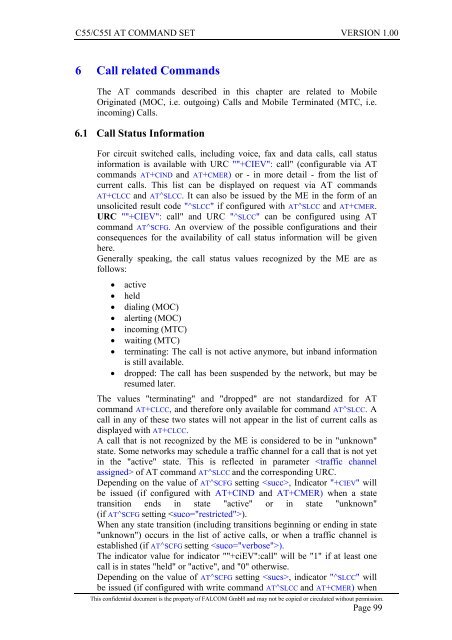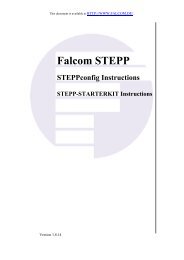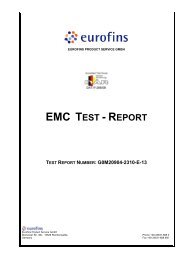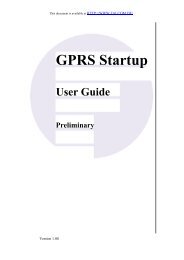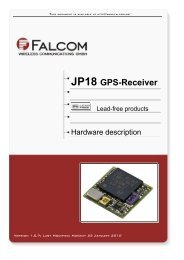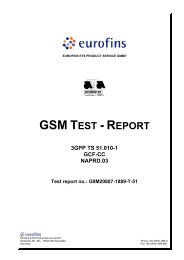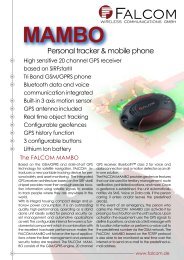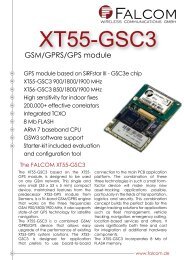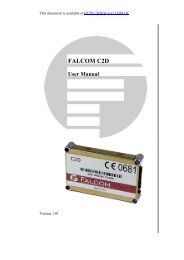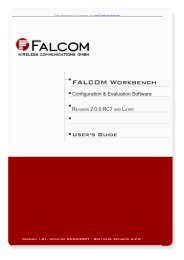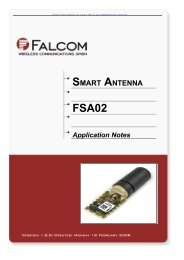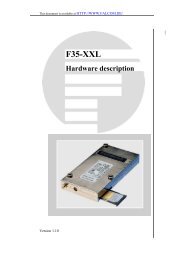C55/C55i AT COMMAND SET Description Preliminary - Falcom
C55/C55i AT COMMAND SET Description Preliminary - Falcom
C55/C55i AT COMMAND SET Description Preliminary - Falcom
Create successful ePaper yourself
Turn your PDF publications into a flip-book with our unique Google optimized e-Paper software.
<strong>C55</strong>/<strong>C55</strong>I <strong>AT</strong> <strong>COMMAND</strong> <strong>SET</strong> VERSION 1.00<br />
6 Call related Commands<br />
The <strong>AT</strong> commands described in this chapter are related to Mobile<br />
Originated (MOC, i.e. outgoing) Calls and Mobile Terminated (MTC, i.e.<br />
incoming) Calls.<br />
6.1 Call Status Information<br />
For circuit switched calls, including voice, fax and data calls, call status<br />
information is available with URC ""+CIEV": call" (configurable via <strong>AT</strong><br />
commands <strong>AT</strong>+CIND and <strong>AT</strong>+CMER) or - in more detail - from the list of<br />
current calls. This list can be displayed on request via <strong>AT</strong> commands<br />
<strong>AT</strong>+CLCC and <strong>AT</strong>^SLCC. It can also be issued by the ME in the form of an<br />
unsolicited result code "^SLCC" if configured with <strong>AT</strong>^SLCC and <strong>AT</strong>+CMER.<br />
URC ""+CIEV": call" and URC "^SLCC" can be configured using <strong>AT</strong><br />
command <strong>AT</strong>^SCFG. An overview of the possible configurations and their<br />
consequences for the availability of call status information will be given<br />
here.<br />
Generally speaking, the call status values recognized by the ME are as<br />
follows:<br />
• active<br />
• held<br />
• dialing (MOC)<br />
• alerting (MOC)<br />
• incoming (MTC)<br />
• waiting (MTC)<br />
• terminating: The call is not active anymore, but inband information<br />
is still available.<br />
• dropped: The call has been suspended by the network, but may be<br />
resumed later.<br />
The values "terminating" and "dropped" are not standardized for <strong>AT</strong><br />
command <strong>AT</strong>+CLCC, and therefore only available for command <strong>AT</strong>^SLCC. A<br />
call in any of these two states will not appear in the list of current calls as<br />
displayed with <strong>AT</strong>+CLCC.<br />
A call that is not recognized by the ME is considered to be in "unknown"<br />
state. Some networks may schedule a traffic channel for a call that is not yet<br />
in the "active" state. This is reflected in parameter of <strong>AT</strong> command <strong>AT</strong>^SLCC and the corresponding URC.<br />
Depending on the value of <strong>AT</strong>^SCFG setting , Indicator "+CIEV" will<br />
be issued (if configured with <strong>AT</strong>+CIND and <strong>AT</strong>+CMER) when a state<br />
transition ends in state "active" or in state "unknown"<br />
(if <strong>AT</strong>^SCFG setting ).<br />
When any state transition (including transitions beginning or ending in state<br />
"unknown") occurs in the list of active calls, or when a traffic channel is<br />
established (if <strong>AT</strong>^SCFG setting ).<br />
The indicator value for indicator ""+ciEV":call" will be "1" if at least one<br />
call is in states "held" or "active", and "0" otherwise.<br />
Depending on the value of <strong>AT</strong>^SCFG setting , indicator "^SLCC" will<br />
be issued (if configured with write command <strong>AT</strong>^SLCC and <strong>AT</strong>+CMER) when<br />
This confidential document is the property of FALCOM GmbH and may not be copied or circulated without permission.<br />
Page 99


